🔭🌃🌌
🔭🌃🌌
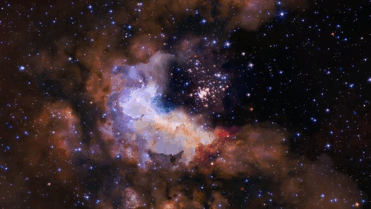
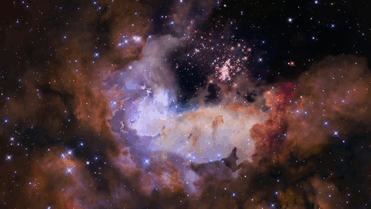
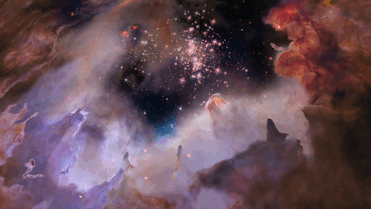
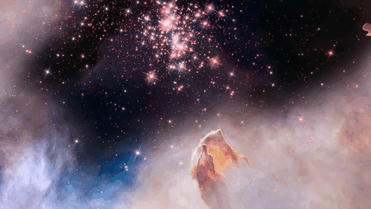
Celestial Fireworks: Into Star Cluster Westerlund 2
What if you could go directly to a cluster where the stars are forming? This animation was done with 3D computer modeling of the region around the star cluster Westerlund 2, based on Hubble Space Telescope images in visible and infrared light. Westerlund 2 covers about 10 light-years and is about 20 thousand light years distant towards the constellation Keel of the ship (Carina). As the illustrative animation begins, the larger Gum 29 nebula fills the screen with the young group of bright stars visible in the center. Stars pass your finger as you approach the cluster. Soon, your imaginary vessel rotates and you pass over the interstellar gas and dust pillars during the light year. Strong winds and radiations from young, massive stars destroy all but the densest clumps of dust, leaving these pillars in their shadows - many pointing back to the center of the cluster. Lastly, you move to the top of the set of stars and search hundreds of the most gigantic stars known.
Credit: NASA, ESA, Hubble, J. Anderson et al. (STScI); Acknowledgment: The Hubble Heritage Team (STScI/AURA), A. Nota (ESA/STScI), the Westerlund 2 Science Team, and the ES
More Posts from Monstrous-mind and Others
🌄🍁🍂🌫🎃

🐈⬛🐈🌌🌆🌕

Pixabay
🍂🍁🍂🍁

~ Orange and Brown ~
🎃🍁🍂🐈🐾🍂🍁🎃
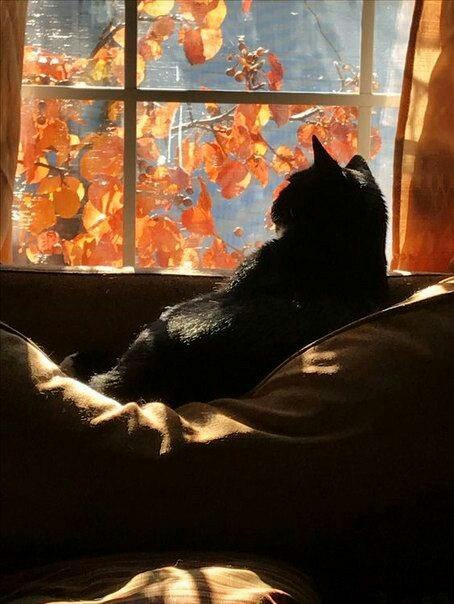


The NASA/ESA Hubble Space Telescope captures the iridescent tapestry of star birth in a neighbouring galaxy in this panoramic view of glowing gas, dark dust clouds, and young, hot stars.
Credit: NASA/ESA and the Hubble Heritage Team (AURA/STScI/HEIC)
🐾🐈💀

🍂🍁📚☕🐈🎃🍁🍂

What’s Up For September 2018?
Outstanding views Venus, Jupiter, Saturn and Mars with the naked eye!

You’ll have to look quickly after sunset to catch Venus. And through binoculars or a telescope, you’ll see Venus’s phase change dramatically during September - from nearly half phase to a larger thinner crescent!

Jupiter, Saturn and Mars continue their brilliant appearances this month. Look southwest after sunset.

Use the summer constellations help you trace the Milky Way.

Sagittarius: where stars and some brighter clumps appear as steam from the teapot.

Aquila: where the Eagle’s bright Star Altair, combined with Cygnus’s Deneb, and Lyra’s Vega mark the Summer Triangle.

Cassiopeia, the familiar “w”- shaped constellation completes the constellation trail through the Summer Milky Way. Binoculars will reveal double stars, clusters and nebulae.

Between September 12th and the 20th, watch the Moon pass from near Venus, above Jupiter, to the left of Saturn and finally above Mars!

Both Neptune and brighter Uranus can be spotted with some help from a telescope this month.

Look at about 1:00 a.m. local time or later in the southeastern sky. You can find Mercury just above Earth’s eastern horizon shortly before sunrise. Use the Moon as your guide on September 7 and 8th.

And although there are no major meteor showers in September, cometary dust appears in another late summer sight, the morning Zodiacal light. Try looking for it in the east on moonless mornings very close to sunrise. To learn more about the Zodiacal light, watch “What’s Up” from March 2018.

Watch the full What’s Up for September Video:
There are so many sights to see in the sky. To stay informed, subscribe to our What’s Up video series on Facebook.
Make sure to follow us on Tumblr for your regular dose of space: http://nasa.tumblr.com
#Cool
What’s Enceladus?
Before we tell you about Enceladus, let’s first talk about our Cassini spacecraft…
Our Cassini mission to Saturn is one of the most ambitious efforts in planetary space exploration ever mounted. Cassini is a sophisticated robotic spacecraft orbiting the ringed planet and studying the Saturnian system in detail.

Cassini completed its initial four-year mission to explore the Saturn System in June 2008. It has also completed its first mission extension in September 2010. Now, the health spacecraft is making exciting new discoveries in a second extension mission!
Enceladus

Enceladus is one of Saturn’s many moons, and is one of the brightest objects in our solar system. This moon is about as wide as Arizona, and displays at least five different types of terrain. The surface is believed to be geologically “young”, possibly less than 100 million years old.
Cassini first discovered continually-erupting fountains of icy material on Enceladus in 2005. Since then, the Saturn moon has become one of the most promising places in the solar system to search for present-day habitable environments.

Scientists found that hydrothermal activity may be occurring on the seafloor of the moon’s underground ocean. In September, it was announced that its ocean –previously thought to only be a regional sea – was global!
Since Cassini is nearing the end of its mission, we are able to make a series of three close encounters with Enceladus, one of Saturn’s moons.
Close Encounters
On Oct. 14, Cassini performed a mid-range flyby of Enceladus, but the main event will take place on Oct. 28, when Cassini will come dizzyingly close to the icy moon. During this flyby, the spacecraft will pass a mere 30 miles above the moon’s south polar region!

This will be the deepest-ever dive through the moon’s plume of icy spray, where Cassini can collect images and valuable data about what’s going on beneath the frozen surface.
Make sure to follow us on Tumblr for your regular dose of space: http://nasa.tumblr.com
-
 iwannarunaway-13 liked this · 2 weeks ago
iwannarunaway-13 liked this · 2 weeks ago -
 mariannetheflash reblogged this · 3 months ago
mariannetheflash reblogged this · 3 months ago -
 mariannetheflash liked this · 3 months ago
mariannetheflash liked this · 3 months ago -
 unlisted404606 reblogged this · 4 months ago
unlisted404606 reblogged this · 4 months ago -
 unlisted404606 liked this · 4 months ago
unlisted404606 liked this · 4 months ago -
 seima-tenshi liked this · 7 months ago
seima-tenshi liked this · 7 months ago -
 wanderer001 reblogged this · 7 months ago
wanderer001 reblogged this · 7 months ago -
 wanderer001 liked this · 7 months ago
wanderer001 liked this · 7 months ago -
 seasons-in-hell liked this · 7 months ago
seasons-in-hell liked this · 7 months ago -
 instructions-not-included liked this · 7 months ago
instructions-not-included liked this · 7 months ago -
 whitewalker13 liked this · 7 months ago
whitewalker13 liked this · 7 months ago -
 shannybangbang reblogged this · 7 months ago
shannybangbang reblogged this · 7 months ago -
 dotglobal liked this · 10 months ago
dotglobal liked this · 10 months ago -
 zurgy-space reblogged this · 11 months ago
zurgy-space reblogged this · 11 months ago -
 zurgy liked this · 11 months ago
zurgy liked this · 11 months ago -
 odinosiris6 reblogged this · 1 year ago
odinosiris6 reblogged this · 1 year ago -
 odinosiris6 liked this · 1 year ago
odinosiris6 liked this · 1 year ago -
 demichrising liked this · 1 year ago
demichrising liked this · 1 year ago -
 anderwhohn reblogged this · 1 year ago
anderwhohn reblogged this · 1 year ago -
 geeky-introvert reblogged this · 1 year ago
geeky-introvert reblogged this · 1 year ago -
 geeky-introvert liked this · 1 year ago
geeky-introvert liked this · 1 year ago -
 frauleinvonmausefels reblogged this · 1 year ago
frauleinvonmausefels reblogged this · 1 year ago -
 commred liked this · 1 year ago
commred liked this · 1 year ago -
 therealityhelix reblogged this · 1 year ago
therealityhelix reblogged this · 1 year ago -
 doomed-knight reblogged this · 1 year ago
doomed-knight reblogged this · 1 year ago -
 odin606 reblogged this · 2 years ago
odin606 reblogged this · 2 years ago -
 odin606 liked this · 2 years ago
odin606 liked this · 2 years ago -
 fortunebow reblogged this · 2 years ago
fortunebow reblogged this · 2 years ago -
 virginlibertine reblogged this · 2 years ago
virginlibertine reblogged this · 2 years ago -
 virginlibertine liked this · 2 years ago
virginlibertine liked this · 2 years ago -
 ir0n-angel reblogged this · 2 years ago
ir0n-angel reblogged this · 2 years ago -
 xploseof reblogged this · 2 years ago
xploseof reblogged this · 2 years ago -
 ovrgrwn reblogged this · 2 years ago
ovrgrwn reblogged this · 2 years ago -
 mellowmelancholia reblogged this · 2 years ago
mellowmelancholia reblogged this · 2 years ago -
 bluebird606 reblogged this · 2 years ago
bluebird606 reblogged this · 2 years ago -
 bluebird606 liked this · 2 years ago
bluebird606 liked this · 2 years ago -
 iwillruletheuniverse reblogged this · 2 years ago
iwillruletheuniverse reblogged this · 2 years ago -
 s0urce--flow liked this · 2 years ago
s0urce--flow liked this · 2 years ago -
 heartendures liked this · 2 years ago
heartendures liked this · 2 years ago -
 heartendures reblogged this · 2 years ago
heartendures reblogged this · 2 years ago -
 lotesseflower reblogged this · 2 years ago
lotesseflower reblogged this · 2 years ago -
 lotesseflower liked this · 2 years ago
lotesseflower liked this · 2 years ago
My ambition is handicapped by laziness. -C. Bukowski Me gustan las personas desesperadas con mentes rotas y destinos rotos. Están llenos de sorpresas y explosiones. -C. Bukowski. I love cats. Born in the early 80's, raised in the 90's. I like Nature, Autumn, books, landscapes, cold days, cloudy Windy days, space, Science, Paleontology, Biology, Astronomy, History, Social Sciences, Drawing, spending the night watching at the stars, Rick & Morty. I'm a lazy ass.
222 posts